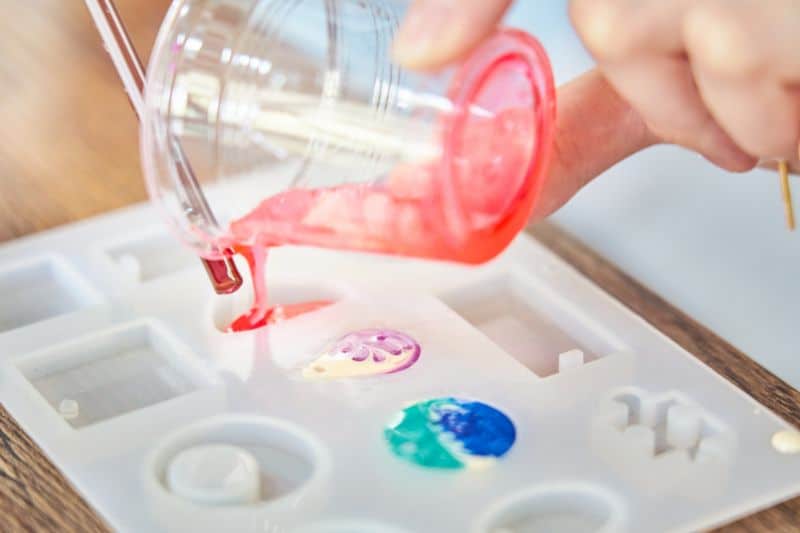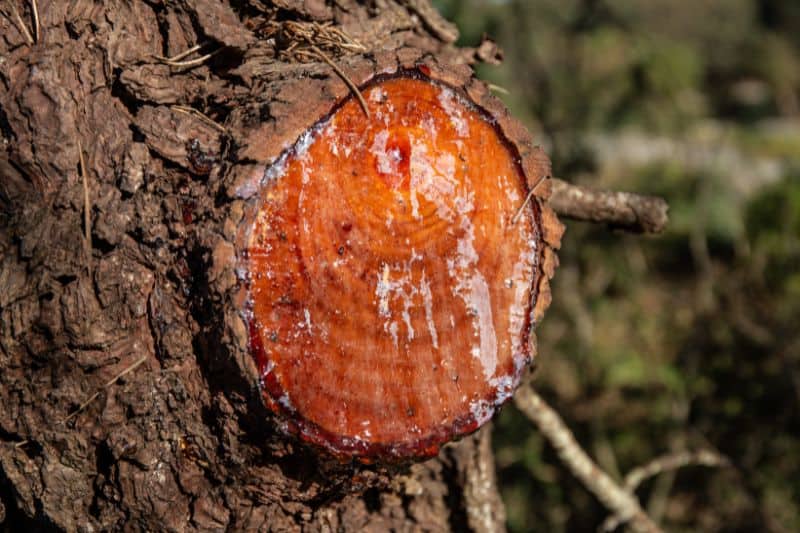Have you ever wondered what that intriguing, yellow, sticky substance secreted by pine trees is?
Well, that’s what we call resin!
Resin comes as a natural secretion found in pine trees, but it can also be crafted synthetically. Over time, it has evolved into one of the most widely used substances worldwide.
But then, with the growing popularity of this material arises the question — Is resin bad for the environment?
If you’ve found yourself pondering this very question, you’re in the right place. Read on to understand more about resin and whether or not it makes an enemy of the environment.
Does Resin Harm the Environment?
While natural resin doesn’t harm the environment, most synthetic resin products are not environmentally friendly. The natural one is exuded from trees, especially pines and firs, and occurs as a result of injury to the bark from wind, fire, lightning, or other causes.
These resins are organic substances that are both fusible and flammable, soluble in various organic solvents except for water. Some types of natural resin are used in medicinal applications, serve as solvents, and contribute to varnishes.
Oil-soluble resins have historical uses in soap and varnish production, and the hardest natural resins find application in jewelry. Being derived from organic sources, namely trees, they pose no harm to the environment.
Regrettably, modern natural resins have largely been supplanted by synthetic counterparts, which are less environmentally friendly. Most synthetic resin products have the potential to release hazardous substances into the environment and water systems, particularly when disposed of improperly.
Some types of resin have also been found to have adverse effects on animals and humans, such as carcinogens. However, the environmental impact of resins varies significantly due to their diversity, making it challenging to categorize them all as harmful or benign.
Recognizing these concerns, some eco-conscious manufacturers are addressing the issue by introducing eco-friendly bio-resins. The primary reason synthetic resins pose an environmental threat is their origin from fossil fuels and the reliance on chemical processes. These chemicals can irritate the skin, eyes, and respiratory health upon exposure.
Why is Resin Bad For the Environment?
Resin carries a notable burden on the environment, primarily due to the intricacies of its production process, which is deeply intertwined with the extensive utilization of fossil fuels and an array of chemicals.
The problem resin brings to the problem begins with how the production is done. Industrial synthetic resins, the kind commonly used in resin art and numerous applications, begin their transformation with the heating of hydrocarbons.
This thermal process, known as ‘cracking,’ involves the controlled application of heat to break down intricate hydrocarbon molecules into simpler compounds. These newfound compounds then serve as the building blocks for the intricate polymer structures that constitute various types of resin.
Unfortunately, this process requires the use of fossil fuels, especially in the critical part of the cracking process. These non-renewable resources, including oil and natural gas, are ignited to generate the intense heat required for the initial stages of cracking.
While it’s a vital component of the resin production process, this heavy reliance on fossil fuels contributes to both resource depletion and environmental pollution. In fact, these fossil fuels remain the leading culprit behind the current global warming quagmire.

Let’s see how different types of resin contribute to global warming and climatic change:
Polyester or Fiberglass Resin
This is generally the cheapest type of resin and also the most toxic. Inhaling the fumes from this resin can cause respiratory problems, irritation to eyes and skin, and its chemicals are water-polluting.
Polyester resins are often made using styrene, which makes it possibly carcinogenic to humans. The resin is also highly flammable and should not be kept around too much heat, static, or sources of ignition. It must be disposed of as hazardous waste and avoid groundwater and drains to avoid contamination.
Epoxy Resin
This is the most popular type of resin around. Unlike polyester resins, which are pretty malodorous and can release harmful gases, epoxy resins are primarily known for the harm they cause to human health. Breathing in vapors from epoxy resins can result in the development of asthma in people who are not using proper protection.
Chemicals used in the epoxy resin can also cause cancer and genetic mutations in animals, though newer products should have fewer carcinogens, provided they do not use epichlorohydrin.
In addition, this resin can cause allergies and dermatitis, especially after contact with the skin, and it is always more prudent to handle epoxy resins with gloves, goggles, and protective clothing to prevent the risks of contact and splashing.
Polyurethane Resin
This is a more environmentally friendly version, although that depends on the manufacturer. It can still pollute water via drains, the ground, and watercourses, and the relevant authorities should be informed of the environmental pollution.
Polyurethane is known to be a bit friendly to the environment in comparison to plastics, but it still releases carbon dioxide, one of the primary culprits of global warming.
The Non-Reactive Variety
Artist resins can either be reactive or non-reactive. The non-reactive variety is dangerous because when mixed, they release volatile organic compounds (VOCs) during a chemical reaction and would leach over time. Putting cheap epoxy resin in water will make chemicals leach out of it. This is hazardous to your health and the environment.
Having examined the different types of resins, let’s look at their decomposition and whether there are environmentally-friendly alternatives.
Decomposition of Resins

Since these products are made from plastics, their biodegradability is also an issue. In fact, most of the resin is not biodegradable. This means that traditional resins could last in the environment forever, leeching chemicals and releasing carbon dioxide daily for hundreds of years.
However, there has been the introduction of biodegradable resins, which are known to be 100% biodegradable and recyclable. They are also made from non-toxic and non-hazardous raw materials. These types of resins were only developed in 2011 and still have a long way to go.
Environmentally-Friendly Alternatives
These alternatives have only surfaced over the last few years and are better than the traditional resin we are used to. If you are looking to craft with resin or resin-like materials, consider the sustainable alternatives.
They include:
- Ecopoxy: It’s a bio-based, plant-based epoxy “resin” specifically and sustainably made for woodworking.
- Terra Cast resin: It’s another sustainable option, as all of its colors are made from mainly recycled materials.
- Black resin: This type is made from post-consumer recycled materials.
Other environmentally safe alternative resins include hard plaster or concrete for casting, alabaster, slush latex, or metal. However, despite their alternative nature, each material comes at some kind of cost and requires additional research.
How Long Does Resin Take to Decompose?
Synthetic resins are made from fossil fuels, meaning they will take forever to biodegrade fully. It is one of the reasons why they are not environmentally friendly, and alternatives were developed.
Although the alternatives have been certified to be fully recyclable and biodegradable, not much has been said about the duration it will take for them to biodegrade fully. These contemporary resins are made from recyclables and are recyclable by themselves.
However, they are also meant to be highly durable and can, therefore, last a long time before having to be recycled without harming any natural resources. All resources available are advocating for recycling rather than letting the biodegradable and environmentally friendly resin decompose.
It is, therefore, unclear how long it will take for the safe resins to decompose, although they can be recycled multiple times and converted into something new.
Is Resin Flammable?
Yes and No, depending on the type of resin. As you can imagine, the natural resin from trees is not flammable. However, this does not mean the resin won’t burn in case the tree is put ablaze. It will, with the only difference being that it’s less likely to catch fire than other types of resin.
You do not imagine you can find resin lying around after a wildfire. They will burn up but are not prone to the fire by themselves.
Now, let’s look into the man-made ones.
Cured epoxy resin is not flammable and, in fact, is fire-resistant. However, the uncured one is flammable.
Casting resin is flammable, and so is polyester resin, especially before curing. In fact, polyester resin has a low flashpoint of 35 °C (86 °F) and can catch fire quite easily.
This is much, much more flammable than epoxy, and it means that on a warm day, the flashpoint is easily achieved, and any spark or flame could trigger a polyester resin fire.
Therefore, take extra caution when handling polyester resins. Also, never work with polyester resin around anything with an open flame or any kind of electrical equipment that might spark.
Polyester resin is highly flammable when wet, particularly if it is being cured with acetone, another ridiculously flammable substance.
For epoxy resin to catch fire, it requires a higher temperature. This is why epoxy rein requires careful handling, and those who use it know to work outdoors or in a well-ventilated space, as well as to mix the reagents away from naked flames.
When working with synthetic resins, also be sure to wear proper respiratory protection to prevent you from inhaling the fumes, which are also toxic as well as flammable. You should also use a water spray to cool the containers with the resin in.
This reduces the chance of vapor pressure build-up in the containers and, hopefully, prevents any form of auto-ignition or explosion. Art resin, a form of epoxy resin, is also flammable, especially before being mixed, although the curing agent will not be flammable.
Surprisingly, once mixed and after curing, it is not flammable. UV resin is a form of resin that cures in sunlight using UV light to drive the curing reaction and is neither flammable nor toxic.

Is Resin Environmentally Friendly?
This depends on the type of resin. Natural resin from the trees is organic and is perfect for the environment. Synthetic resin made using fossil fuels, as you can tell, is not environmentally friendly.
It requires the use of chemicals to treat, which harm the environment and human health. It also continues the never-ending reliance on fossil fuels, which are non-renewable and, once used, release carbon dioxide and other gases that harm the environment.
Luckily, over the years, there has been the introduction of ‘green’ resins, which are said to be environmentally friendly. They are made from plant-based substances as well as recycled and recyclable materials, making the end product environmentally friendly and non-toxic.
Unfortunately, compared to synthetic resins, the eco or bio-resins are much more expensive because they are newer and require the use of much more expensive materials to produce. Luckily, as the technology for eco-resins develops, more manufacturers will see the benefit of selling this as their product, and the price will lower.
However, be very wary of greenwashing companies that claim to have “non-toxic” resins instead of eco-resins. Greenwashing is a marketing practice of claiming to be more eco-friendly than they are.
References:
https://www.britannica.com/science/resin
https://resineepoxy.ca/en/2019/03/29/a-green-epoxy-system-seriously/






